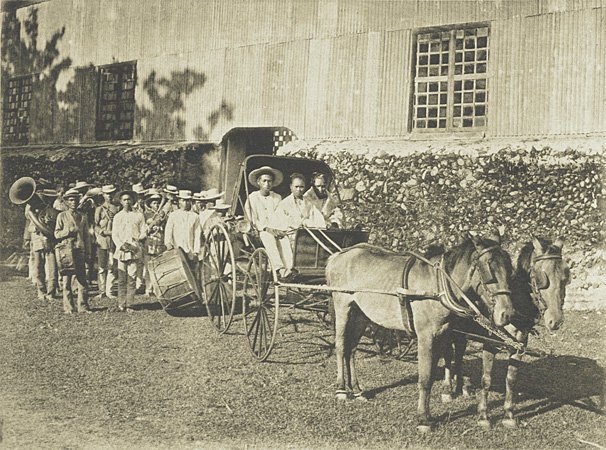Cultural Center of the Philippines
ENCYCLOPEDIA OF
PHILIPPINE ART
Recuerdos de Filipinas
(Memories of the Philippines) / 1895 / Artist: Felix Laureano / American Historical Collection, Ateneo de Manila University
An album that seeks to explain the customs of the Philippines, Recuerdos de Filipinas is believed to be the first collection of photographic works made by a Filipino. The dedication page states: “Al insigne y laureado pintor filipino D. Juan Luna y Novicio Dedica este album-libro, Recuerdos de Filipinas, en homenaje de admiracion a sú talento de artista” (Dedicated to the famous and award-winning Filipino painter D. Juan Luna y Novicio as tribute of admiration to his talent as an artist). This inscription is noteworthy for the appropriation of the name “Filipino” by a non-Spanish. Here is Laureano, who hails from Iloilo, recognizing a compatriot from the province of Ilocos, demonstrating that “Filipino” now refers to the people of various provinces comprising the country Philippines. Further, the work acknowledges a fellow Filipino who has just become famous internationally.
The album is composed of 37 sections, each with a photograph serving as illustration of the activity or the people being introduced to a Spanish-speaking reader, the work’s language being Spanish. Pictures can be categorized into five sets: (1) important events such as wedding and funeral, (2) daily activities, (3) profiles of people, (4) the land, and (5) the structures. The author-photographer selects scenes that he considers “typical”: bathing as a common activity; types of people from the Bisaya to a Caroline import to the Philippine Exposition in Madrid, to a mestizo; and the church as monument of culture among the Filipinos. Photographs are titled with un/una, en el/la, tipos to underscore objectivity, while the present progressive tense of Spanish verbs is used, denoting that the pictures depict the “present” state of Philippine culture and society. While the photo titles seem to be distant and disinterested, the descriptions overflow with passion, as can be seen in this passage (translated from the Spanish) referring to washing clothes: “And languishing in their tender illusions, they await with impatience the return of their dear beloved, of delirious loves” (95).
The first photograph that serves as the book’s cover, Una Boda (A Wedding), shows how people back then celebrate the important occasion of consecrating their union. The couple rides a carriage that would transport them from the church to their home. It affords a glimpse into the past: men and women in formal attire of the time, wearing white hats, men playing drums and trumpets at community festivities. Yet the band members and guests behind the newlyweds’ carriage march with bare feet, apparently a common yet puzzling practice, as verified by other pictures, where people wear formal clothing with their feet dirtied by the earth as they move along. The bride and the groom are not smiling and their formality is further stiffened by the pressure to be composed under the glaring heat of the afternoon sun.
Laureano’s work is priceless for its work of documenting the people’s preoccupations, their clothing and looks, equipment, shelter, some flora and fauna, and the roads and other public facilities. There are pictures of pristine landscapes while others show places that already have infrastructures built by the people, demonstrating art, technology, and culture. It appears that people were looking at the photographer when the pictures were being taken, some puzzled, others annoyed, but all with the recognition that an image of them was being taken. It is not clear whether their permission to be photographed was sought. Just the same, the pictures seem to have been taken with a gaze from above the social ladder that—even though belonging to a fellow countryman—looks upon the subjects as “special others” that need to be scrutinized and presented to a viewer who does not belong to the subjects’ environment, the foreigner in Europe. Inevitably, a colonial gaze imbibed by the ascendant Filipino haunts the settings that Laureano pictured.
Written by JPaul S. Manzanilla
Sources
Laureano, Felix. 1895. Recuerdos de Filipinas. Barcelona: A. Lopez Robert.
———. 2001. Recuerdos de Filipinas. Translated by Felice Noelle Rodriguez. Mandaluyong: Anvil Publishing Inc.
